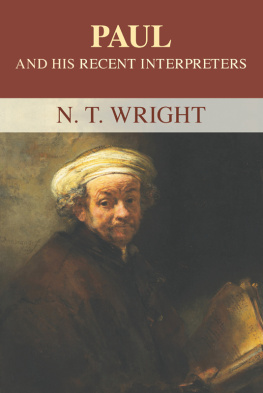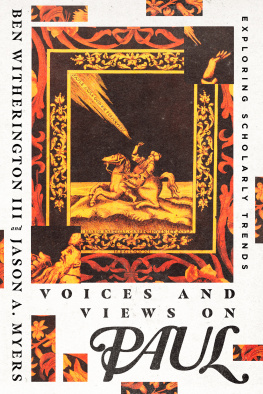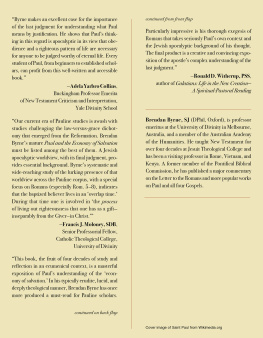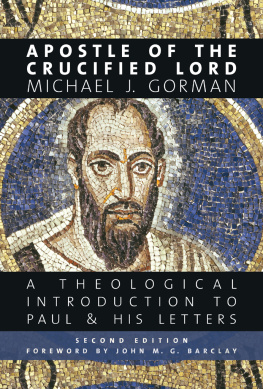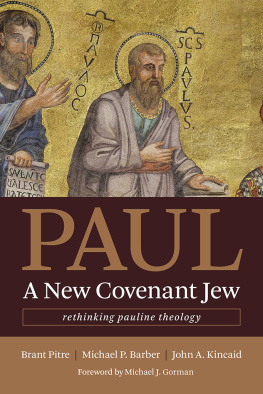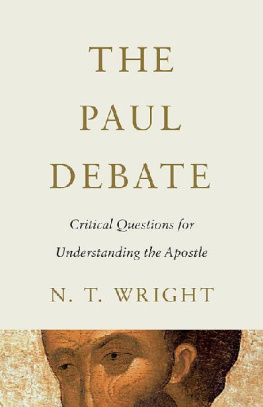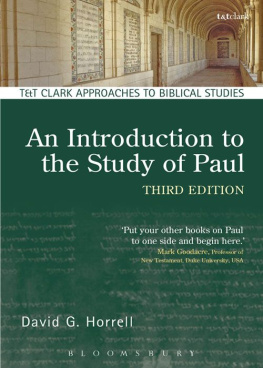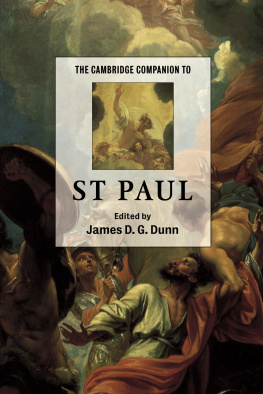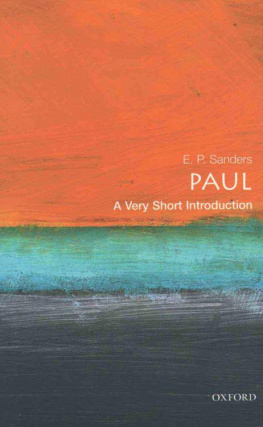PAUL AND HIS RECENT INTERPRETERS
PAUL AND HIS RECENT INTERPRETERS
SOME CONTEMPORARY DEBATES
N. T. Wright
University of St Andrews
First published in Great Britain 2015
Society for Promoting Christian Knowledge
36 Causton Street
London SW1P 4ST
www.spck.org.uk
Copyright Nicholas Thomas Wright 2015
All rights reserved. No part of this book may be reproduced or
transmitted in any form or by any means, electronic or
mechanical, including photocopying, recording, or by any
information storage and retrieval system, without permission in
writing from the publisher.
Unless otherwise stated,
quotations from the New Testament are from the authors own
The New Testament for Everyone (London: SPCK, 2011;
published by HarperOne, San Francisco, as The Kingdom New Testament)
while those from the Old Testament are either the authors own translation or are taken from the New Revised Standard Version of the Bible, Anglicized Edition,
copyright 1989, 1995, reprinted by permission of
the National Council of the Churches of Christ in the USA. All rights reserved.
British Library Cataloguing-in-Publication Data
A catalogue record for this book is available from the British Library
ISBN 9780281067589
eBook ISBN 9780281067596
Typeset by Tom Wright, St Andrews, using Nota Bene software
eBook by Data Standards Ltd, Frome, Somerset
To my students, past and present
Contents
Contemplating this book in its final form, I am reminded of a whimsical article by the journalist Bernard Levin concerning a railway enthusiast who was producing a series of articles called Some Smaller English Signal-Boxes. Levin imagined the life story behind this strangely humble project. Perhaps, he mused, the man had begun in his youth to research Signal Boxes of the World. Then, as adult responsibilities crowded in, he decided to limit his ambitions to the English variety. Then, with the onset of middle age, realizing that further curtailment would be needed, he chose to study only the smaller signal-boxes of England. Finally, as retirement beckoned, he had to face the fact that, even there, a complete survey was out of the question, and so had introduced the tell-tale word some into the title.
The reader of the present volume will note that its subtitle, too, contains the word some. It might have been good to write about Pauline Scholarship around the World, but I have had to limit my survey almost entirely to certain debates current within the Anglophone world. Thus, though my own tale is less whimsical, it still has some analogies with that of Levins anti-hero.
When I began postgraduate studies on Paul in the early 1970s, we knew more or less where we were. The German scholars still led the way. We might disagree, but we were disagreeing with the (very different) positions of Bultmann, Bornkamm, Conzelmann, Jeremias, Ksemann and the rest. Some helpfully traced the genealogy of these views back to earlier luminaries like Wrede and Schlatter.
Meanwhile, the French were introducing structuralist insights. We in Britain were still reading C. H. Dodd, and sitting at the feet of luminaries such as Charlie Moule in Cambridge, C. K. Barrett in Durham, and George Caird in Oxford. In America, the older work of John Knox still carried weight, though a new trend could be observed: Germans invent methods, Americans apply them, and British pragmatists sit in between, claiming that they are just trying to read the texts. Roman Catholic biblical scholarship was given official permission to spread its wings when the Second Vatican Council produced Dei Verbum in 1965. Since then, many Roman Catholic exegetes have produced splendid work on Paul. I think, for instance, of the creative and innovative studies of Jean-Noel Aletti in Rome.
All these movements have continued. The old debates are still going on; many still pursue them energetically. But the landscape has changed completely. This book tries to describe that change; perhaps even to explain it.
An illustration may help. Someone who grew up in London in the 1950s might still be there today, living the same kind of life. But such a person now shares the city with millions of people from every corner and culture of the world. The stockbroker and the rapper walk the same streets while living totally different lives. Similarly, the scholarly discussions on Paul used to proceed in a well-known and orderly fashion. But the Pauline texts, like the London streets, now play host to a wide variety of different interpretative cultures, starting at different points, asking different questions, engaging with different conversation partners, and inevitably reaching disturbingly different conclusions. Just as the stockbroker and the rapper might stand side by side in Starbucks, and might even strike up a conversation which would reveal their worlds of difference, so the very different worlds of Pauline discussion may sometimes find themselves surprisingly adjacent, with dialogue always possible. Part of the aim of this book is to place them side by side, and to suggest that they might like to talk to one another.
Returning from metaphorical geography to literal, the main geographical focus of New Testament scholarship in general and Pauline research in particular has shifted in my lifetime from Germany to America. This has coincided with a serious glut in production. Discussions both serious and trivial appear every day on the Internet; monographs flood the markets. This makes generalization impossible. One cannot, for instance, point to any single movement in Germany and say, This is where German New Testament scholarship is going, let alone German Pauline scholarship. the Anglophone world has all too often repaid the compliment. I regret that this book continues the trend, for reasons (in my case) of time and space.
A different sort of shift has taken place which creates the social and cultural conditions for some of the key elements in the story this book tries to tell. In the 1960s, most people who wrote about Paul (there were important exceptions) stood within some kind of Christian confession. Now a good deal of biblical research, particularly in the United States, happens in faculties of religion. People in that environment sometimes hint that this setting makes their work objective, by comparison with the subjective or faith-driven work of seminaries, divinity schools, or even the church itself. In Europe, including Britain, there used to be a regular commerce between church and scholarship, though this has worn thin of late. But in America the split between church and state has been defended as much by Christians who forswear the messy business of public life as by secularists who want nothing to do with dangerous outworn superstitions. This new either/or maps all too easily on to other social, cultural and political issues within the culture.
This shift to America, and to religious studies, has had many spin-offs when it comes to understanding the big picture of Paul and his thought. Two of the early flagships of the movement are still important; the present book highlights one in Part I and the other in Part III (we shall come to Part II presently).
The first is E. P. Sanderss Paul and Palestinian Judaism, whose subtitle makes it clear that this is not a work of theology but rather a comparison of patterns of religion. The second is Wayne Meekss The First Urban Christians. For my money, Meekss analysis of Pauls communities is far more shrewd, and historically grounded, than Sanderss. It is ironic that Sanders has become the founding father of one particular so-called perspective on Paul, when actually his really important work was his protest about misrepresentations of the Jewish world. Meekss work on Pauls communities got closer, in my view, to the heart of what those communities actually believed. Both works, however, are symptomatic of the double shift I am talking about: from Germany to America, and from a (usually Lutheran) theological framework to the secular study of religion. Some at least of the sharp and puzzled reactions to the so-called new perspective are as much to do with context as with content (see chapter 5 below).
Next page
